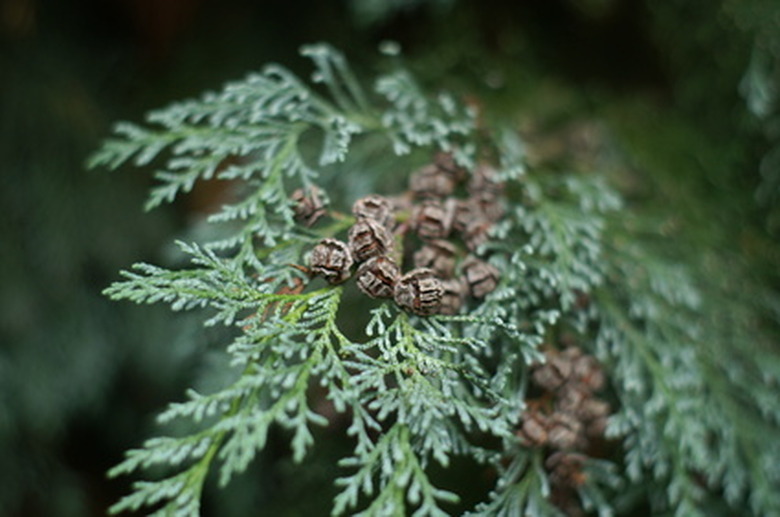Hinoki Cypress Diseases
Hinoki cypress trees (Chamaecyparis obtuse), also called Hinoki false cypress trees, belong to the Cupressaceae plant family. Indigenous to Japan, this tree generally performs well in United States Department of Agriculture (USDA) Hardiness Zones 4 to 8. Mature trees range from 2 to 5 feet in both height and spread.
The Hinoki cypress grows best in fertile, moist soils in partial to full-sun locations. Hinoki cypress trees sometimes suffer from common plant diseases.
Juniper Tip Blight
Juniper tip blight is a fungal disease caused by the Phomopsis juniperovora, Sclerophoma pythiophila or Kabatina juniperi fungi. Early symptoms include shoot tip dieback on the lower twigs and branches. Small fruiting bodies show up as black spots on dead leaves. These bodies release a large number of spores during rainy weather. Severe infections often cause the entire Hinoki cypress to die.
- Hinoki cypress trees (Chamaecyparis obtuse), also called Hinoki false cypress trees, belong to the Cupressaceae plant family.
- Severe infections often cause the entire Hinoki cypress to die.
Juniper tip blight mostly affects younger trees. Fungal pathogens overwinter in fallen barks and twigs, with symptoms appearing in the early spring. Control includes pruning out infected twigs, promoting good air ventilation and using sterilized gardening tools.
Phytophthora Root Rot
Phytophthora root rot, a fungal disease caused by the Phytophthora cinnamomi fungus, needs moist, warm soils to thrive. The soilborne pathogens enter the Hinoki cypress through its root system and work their way into the trunk. This kills the inner bark and causes the outer layer of bark to turn brown. Sap or a gum-like substance often seeps from the discolored bark. The leaves look wilted and drought stressed, generally turning a dull yellow, green or purple color. Preventative measures include planting Hinoki cypress trees in well-drained soils.
- Juniper tip blight mostly affects younger trees.
- Preventative measures include planting Hinoki cypress trees in well-drained soils.
Cytospora Canker
Cytospora canker, a fungal disease caused by the Cytospora pathogens, typically affects stressed or weakened Hinoki cypress trees. The fungal pathogens grow into the tree's bark, eventually girdling the plant and killing any tissue growing above the canker. Early signs include sunken yellow, brown or black areas forming on the twigs and trunk. These sores are surrounded by a swollen callus.
The cankers often ooze spore masses during wet weather. Girdled branches eventually die. Preventative measures include regular watering, applications of fertilizer and proper pruning. Control includes removing infected branches and cleaning the wounds.
- Cytospora canker, a fungal disease caused by the Cytospora pathogens, typically affects stressed or weakened Hinoki cypress trees.
- The cankers often ooze spore masses during wet weather.
Gymnosporangium Rusts
The Gymnosporangium rusts fungal disease causes orange, yellow or red spore masses to develop on the undersides of leaves. Leaf tops typically turn brown or yellow in color. Orange spore masses sometimes form on the infected leaves. Some pathogens cause stunted leaf growth and premature leaf drop. Severe rust infections cause twig dieback and plant death. Prevention includes avoiding overhead watering techniques, applying fungicides and raking up infected needles.
Fungal Scab
Hinoki cypress trees often suffer from fungal scabs (Venturia spp.). This disease causes the formation of dull green to black spots on leaves. Infected leaves often turn red or yellow in color. Severe fungal scab infections cause premature leaf drop and branch dieback. Control includes removing and disposing of fallen needles, applying foliar fertilizers and avoiding overhead watering methods.
- The Gymnosporangium rusts fungal disease causes orange, yellow or red spore masses to develop on the undersides of leaves.
